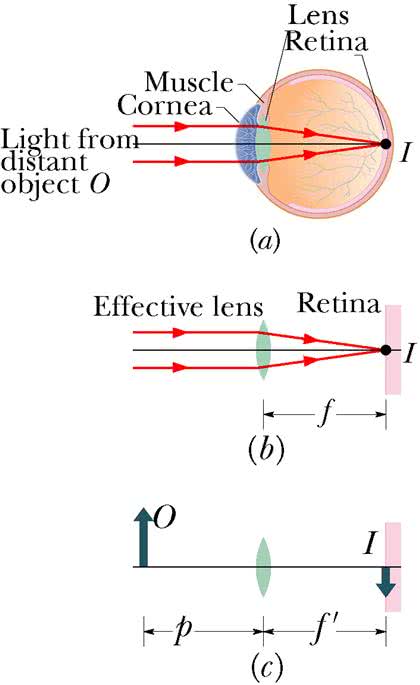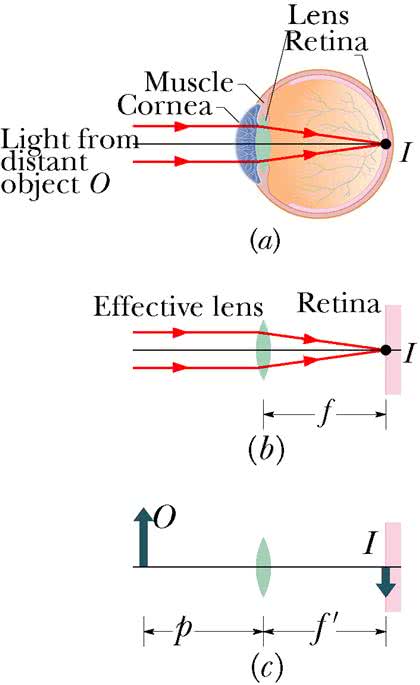AST201H1 Lecture : Lecture 5-Chapter 6-Telescopes

Chapter 6 ± Telescopes
The Eye Forming an Image
x The eyes basic components are a lens, a pupil, and a retina.
x The retina contains light-sensitive cells (cones and rods) that send signals to the brain
via the optic nerve when triggered by light.
x The lens creates an image on your retina because it bends light.
o ie, a light wave is coming to you from a large distance ± a ray of light in a
straight line. When the wave hits your eye, it slows down due to denser matter.
This change in speed is called refraction. If the light wave hits at an angle, the
side of the wave nearest your eye slows down first, allowing the far side to
catch up, changing the direction the light is traveling.
DIAGRAM 6.2, pg 176.
x The bending of light that happens in your eye is precisely tuned to make vision
possible.
x Light rays that enter the lens farther from the center are bent more, and rays that pass
directly through the center are not bent at all. This allows parallel rays of light to
converge to a point called the focus.
x Light rays that are not parallel, like those from a nearby object, enter a lens from
different directions. The rays end up bending to form an image of the original object.
x The place where the image appears in focus is called the focal plane of the lens.
x In an eye with perfect vision, the focal plane is on your retina.
DIAGRAM 6.3
x The image formed by a lens is upside down but is flipped right side up by your brain.
x The pupil of the eye controls the amount of light that enters the eye by adjusting the
size of its opening.
x The pupil dilates/opens wider in low light levels, allowing your eye to gather as many
photons of light as possible; it constrict/narrows in bright light so that your eye is not
overloaded with light.
Recording Images
x &DPHUD¶VRSHUDWLRQLVVLPLODUWRWKDt of an eye, but it makes a permanent record of the
image on film or by using some type of electronic detector.
x The camera lens plays the role of the lens of the eye and the detector, the role of the
retina.
x The shutter is like an eyelid: light can reach the detector only when the shutter is open.
x Advantage of using a camera:
1. Much more reliable and detailed than a drawing.
2. Have control over exposure time ± the amount of time during which light
collects on the detector. A long exposure time means more photons reach the
detector, which means better recording of the details.
x CCDs (charge-coupled devices) are mostly used today to record images, because it is a
chip of silicon made to be extraordinarily sensitive to photons.
x The chip is divided into a grid of squares called picture elements or pixels.
x When a photon strikes a pixel, it causes a bit of electric charge to accumulate until an
exposure is complete, where a computer measures the total electric charge in each
pixel and determines the amount of photons that have struck each pixel.
www.notesolution.com

x The overall image is stored on a memory chip representing the results from each pixel.
(there are 6 million or more pixels in a typical camera chip)
x Advantages over photographic film:
1. Much more sensitive to light ± can record 90%+ of the photons that strike
them, whereas fewer than 10% photons reaching films are coated.
2. Have a much wider dynamic range ± can more easily record both dim and
bright light at the same time.
ie, capturing both the bright galactic center and the outskirts of the
galaxy at the same time.
3. Can be manipulated through techniques of image processing to bring out
details.
DIAGRAM 6.5, pg 177.
Telescopes
The 2 Most Important Properties of a Telescope
x The two most fundamental telescopes can differ are its light-collecting area and its
angular resolution.
x $WHOHVFRSH¶Vlight-collecting area tells us how much total light the telescope can
collect at one time, which is determined by the light-FROOHFWLQJDUHD¶VGLDPHWHU
x The light-collecting area is proportional to WKHVTXDUHRIDWHOHVFRSH¶VGLDPHWHUVRD
relatively small increase in diameter can mean a big increase in light-collecting area.
o ie, a 10-meter telescope has 5 times the diameter of a 2-meter telescope, so its
light-collecting area is 5^2 = 25 times as great.
x Angular resolution is the smallest angle over which we can tell that two dots ± or two
stars ± are distinct.
x The angular separation EHWZHHQWZRSRLQWVRIOLJKWGHSHQGVERWKRQWKHWZRREMHFW¶V
actual separation and on their distance from us.
x In principle, larger telescopes should have better (smaller) angular resolution.
x The ultimate limit WRDWHOHVFRSH¶VUHVROYLQJSRZHUFRPHVIURPWKHSURSHUWLHVRIOLJKW
since light is an electromagnetic wave, beams of light can create an interference with
one another like overlapping sets of ripples on a pond, which causes a blurring of
LPDJHVWKDWOLPLWVDWHOHVFRSH¶VDQJXODUUHVROXWLRQHYHQRWKHUFRQGLWLRQVDUHSHUIHFW
x The angular resolution that a telescope could achieve if it were limited only by the
interference of light waves is called diffraction limit, which depends on both the
GLDPHWHURIWKHWHOHVFRSH¶VSULPDU\PLUURUDQGWKHZDYHOHQJWKof the light being
observed.
x A larger telescope has a smaller diffraction limit; thus, a better (smaller) angular
resolution. The diffraction limit is larger for longer-wavelength light.
o ie, a radio telescope must be far larger than a visible-light telescope to achieve
the same angular resolution.
DIAGRAM 6.6, pg 178.
The 2 Basic Designs of Telescopes
x Telescopes come in 2 basic designs: refracting and reflecting
x A refracting telescope operates much like an eye, using transparent glass lenses to
focus the light from distant objects.
www.notesolution.com

24
AST201H1 Full Course Notes
Verified Note
24 documents
Document Summary
N the eyes basic components are a lens, a pupil, and a retina. N the retina contains light-sensitive cells (cones and rods) that send signals to the brain via the optic nerve when triggered by light. N the lens creates an image on your retina because it bends light. ie, a light wave is coming to you from a large distance a ray of light in a straight line. When the wave hits your eye, it slows down due to denser matter. If the light wave hits at an angle, the side of the wave nearest your eye slows down first, allowing the far side to catch up, changing the direction the light is traveling. N the bending of light that happens in your eye is precisely tuned to make vision possible. N light rays that enter the lens farther from the center are bent more, and rays that pass directly through the center are not bent at all.







